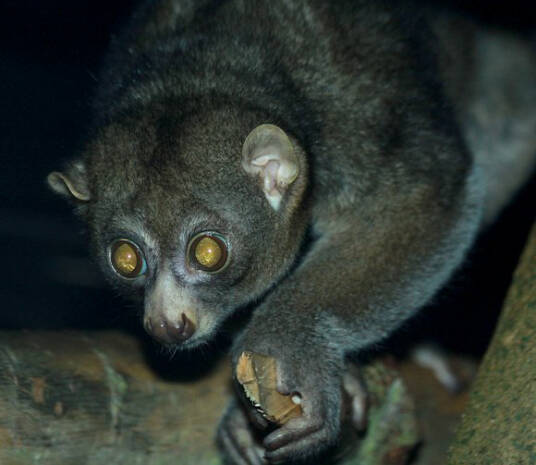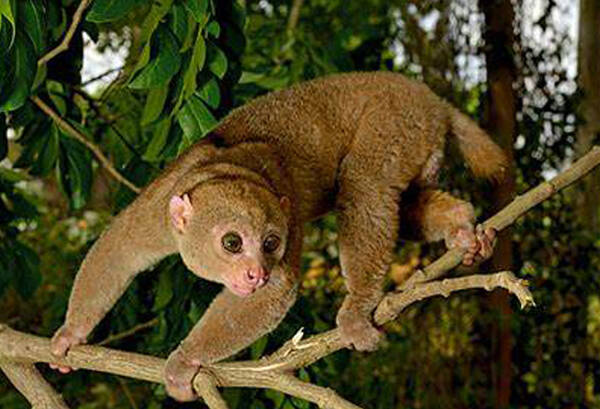Perodicticus potto
IUCN
LCBasic Information
Scientific classification
- name:Perodicticus potto
- Scientific Name:Perodicticus potto,West African Potto、Western Potto
- Outline:Primates
- Family:Loris
Vital signs
- length:30-40cm
- Weight:600-1600g
- lifetime:No verification information
Feature
Has large eyes and small, hairless, round ears
Distribution and Habitat
Distributed in Benin, Côte d'Ivoire, Ghana, Guinea, Liberia, Nigeria, Senegal, Sierra Leone and Togo.
Suspected presence: Gambia and Guinea-Bissau.
Inhabits tropical forests and is found in dense vegetation of rainforests. They can live in a variety of habitats from coastal and lowland forests to mid-elevation mountain forests and can live in primary or secondary forests. They live in forests at altitudes between 600-1830 meters. Usually, the West African Koala monkey is found in trees 5-30 meters high.
Appearance
The West African koala is 30-40 cm long, with a tail length of 3-10 cm and a weight between 600-1600 grams. The hair is curly and gray-brown. It is monomorphic in sex. The species has an elongated body and long limbs, with the forelimbs and hindlimbs being almost equal in length. It has large eyes and small round ears without hair. The coat is dense and varies from brown to gray. They also have common features with other loris, such as a wet nose, tooth comb and toilet claws. Except for the sharp toilet claw on the second finger of the hind foot, the other nails are flat. The index finger is only vestigial. The vestigial second toe and the opposable big toe on the hands and feet form an excellent grip for tree supports. The feet of this species also have a "scapular shield" composed of slender spines of the cervical vertebrae that extend above the outline of the animal's body. The "scapular shield" area serves as a defense against predators and other koalas, an
Details
West African Potto (scientific name: Perodicticus potto) is also known as West African Potto and Western Potto. The 2008 IUCN Red List of Threatened Species classifies all potto monkeys as one species, Perodicticus potto, which includes three subspecies. However, morphological and genetic data, namely data from mitochondrial DNA, indicate that these three subspecies actually belong to independent species names (Pozzi et al., 2015), a finding supported by obvious differences in body shape and skull morphology (Stump 2005). Therefore, they have been regarded as complete and independent species (Nekaris, 2013). Among them, the original nominative subspecies (P. p. potto) was named "West African Potto" (Perodicticus potto), including 2 subspecies, namely the Benin subspecies (Perodicticus potto juju) and the Bosman subspecies (Perodicticus potto potto).

The home range of male West African koalas overlaps with the home ranges of several females, indicating that koalas are hybrids. The territory is large and marked with urine and glandular secretions. It is strongly guarded against same-sex intruders. Females will give part of their territory to mature females, but males will leave their mother's territory when they mature. When male and female koalas meet, they may engage in courtship rituals that include licking, grooming each other with paws and teeth, and scent marking. These rituals are usually performed while both are hanging upside down from a tree branch. Arboreal, nocturnal. Mainly solitary animals, but females carry young. Feed mainly on insects and birds, and sometimes wild fruits.
The breeding season of koalas varies depending on the region they live in, but generally occurs when fruits are most abundant when young are weaned. As part of their courtship rituals, koalas often come together to groom each other. This is often performed while they are hanging upside down from a branch. Grooming includes licking, grooming the fur with grooming paws and teeth, and smearing with scent glands. They mate face to face while hanging upside down from a branch. The duration of the female ovarian cycle is 37-39 days, with a gestation period of 193-205 days, and one litter per birth. The weight of the young monkeys at birth is between 30-52 grams. They are generally weaned at 120-180 days. The young reach adult size and weight at 8-14 months of age and reach sexual maturity at 18 months.
The young are relatively light at birth, but they develop relatively well compared to other primates because they must climb onto the mother's belly and cling to the fur without any maternal handling. They cling to the mother's fur for the first 3-8 days, so they are rarely carried. As the young grow, the mother will hang and hide the young on branches while foraging at night to "park" the young, and the young sleep during the day. At 3-4 months old, the young will follow the mother on her back or behind her to forage, obtaining food and prey from her. Male offspring will stay with their mother until they disperse at 6 months old. Females stay with their mothers until they are 8 months old, when they inherit part of their mother's territory.

The West African Koala is endemic to western Africa, and although the species is known to survive in some disturbed forests near human settlements, the entirety of its range falls within a part of Africa where human populations are growing rapidly and habitat destruction is rampant. In the nine West African countries where the koala monkey has been confirmed, the United Nations Population Division estimates that the total population has increased by 102% from 154 million to 311 million in the 27 years from 1992 to 2019 (United Nations 2019). Associated with the increase in population and the spread of settlement, agriculture, timber extraction, and development projects, FAO (2015) estimates that forest cover in these nine countries has declined from 671.880 km2 in 1990 to 530.900 km2 in 2015. This is a 21% forest loss. Based on analysis of satellite imagery, Guinea, Liberia, and Sierra Leone were three of the ten countries with the fastest accelerating annual loss of tree cover in the world between 2001 and 2014, with Sierra Leone recording the world’s second-largest annual forest loss rate at 12.6% (Peterson et al. 2015).
The koala is also captured by humans, mainly for subsistence, but the species also appears in the commercial trade. This has been observed in the bushmeat trade (Ghana, Côte d'Ivoire, Liberia and Nigeria) to the pet trade (Nigeria, Liberia and Togo), as well as in traditional medicine and conventional trade (Benin, Côte d'Ivoire and Ghana). In the forested areas of West Africa, as larger wild birds become scarce, small mammals are becoming more common in the bushmeat trade. This trend is affecting species such as the koala.
Listed on the IUCN Red List of Threatened Species (IUCN) 2020 ver 3.1 - Near Threatened (NT).
Protect wild animals and stop eating game.
Maintaining ecological balance is everyone's responsibility!








